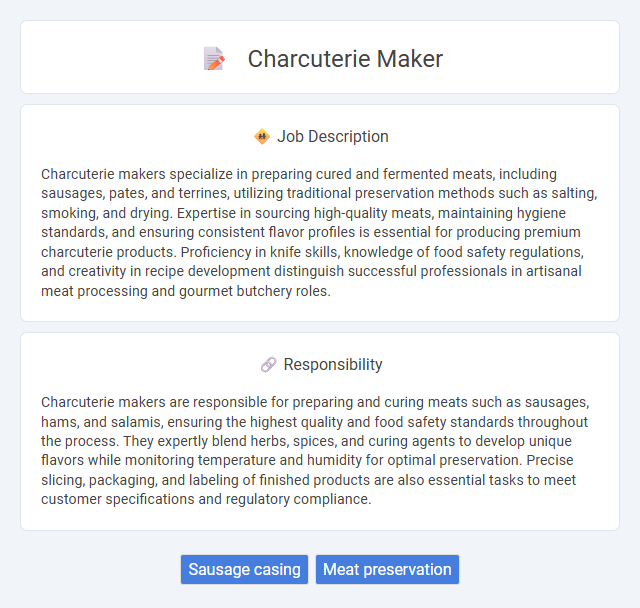
Charcuterie makers specialize in preparing cured and fermented meats, including sausages, pates, and terrines, utilizing traditional preservation methods such as salting, smoking, and drying. Expertise in sourcing high-quality meats, maintaining hygiene standards, and ensuring consistent flavor profiles is essential for producing premium charcuterie products. Proficiency in knife skills, knowledge of food safety regulations, and creativity in recipe development distinguish successful professionals in artisanal meat processing and gourmet butchery roles.
Individuals with strong attention to detail and a passion for food preparation are likely suitable for a charcuterie maker role. Those who can work in cool, fast-paced environments and handle repetitive tasks may find the job conditions manageable. People prone to physical strain or lacking manual dexterity might face challenges in meeting the job's demands.
Qualification
A Charcuterie maker must possess expert knowledge in meat curing, smoking, and preservation techniques, with a strong understanding of food safety and hygiene standards. Proficiency in selecting high-quality meats and seasoning blends is essential to create authentic charcuterie products. Experience with artisan preparation methods and attention to detail ensures consistent, flavorful results that meet industry standards.
Responsibility
Charcuterie makers are responsible for preparing and curing meats such as sausages, hams, and salamis, ensuring the highest quality and food safety standards throughout the process. They expertly blend herbs, spices, and curing agents to develop unique flavors while monitoring temperature and humidity for optimal preservation. Precise slicing, packaging, and labeling of finished products are also essential tasks to meet customer specifications and regulatory compliance.
Benefit
A charcuterie maker job likely offers benefits such as skill development in artisanal meat curing and food preparation, which can enhance culinary expertise. Opportunities for creative expression in flavor combinations and presentation are probably available, contributing to job satisfaction. The role may also provide experience in food safety standards and industry regulations, improving professional qualifications.
Challenge
The charcuterie maker job likely involves the challenge of maintaining consistent quality while experimenting with flavors and curing techniques. There is a high probability that mastering food safety standards and time-sensitive processes adds complexity to the role. Balancing creativity with precision may be essential to meet customer expectations and industry regulations effectively.
Career Advancement
Charcuterie makers develop expertise in curing, smoking, and aging meats, gaining specialized skills that open doors to supervisory roles and artisan product development. Mastery of traditional techniques and food safety regulations enhances opportunities to work in high-end restaurants, specialty food shops, or start independent businesses. Continuous learning and certifications in meat processing can lead to leadership positions and recognition in the gourmet food industry.
Key Terms
Sausage casing
A charcuterie maker specializing in sausage casing meticulously prepares and selects natural or synthetic casings to ensure optimal texture, flavor retention, and safety in sausage production. Expertise in handling collagen, cellulose, and hog casings allows for customized casing choices based on product type, cooking method, and customer preferences. Precise casing management directly impacts the quality, shelf life, and presentation of artisanal sausages in the charcuterie industry.
Meat preservation
Charcuterie makers specialize in preserving meats through traditional curing, smoking, and fermenting techniques that enhance flavor and extend shelf life. Mastery of temperature control, salt concentration, and humidity is essential to prevent spoilage and ensure food safety. Expertise in selecting quality cuts of pork, beef, or game is crucial for producing artisanal salumi, pates, and sausages that meet culinary standards.
 kuljobs.com
kuljobs.com